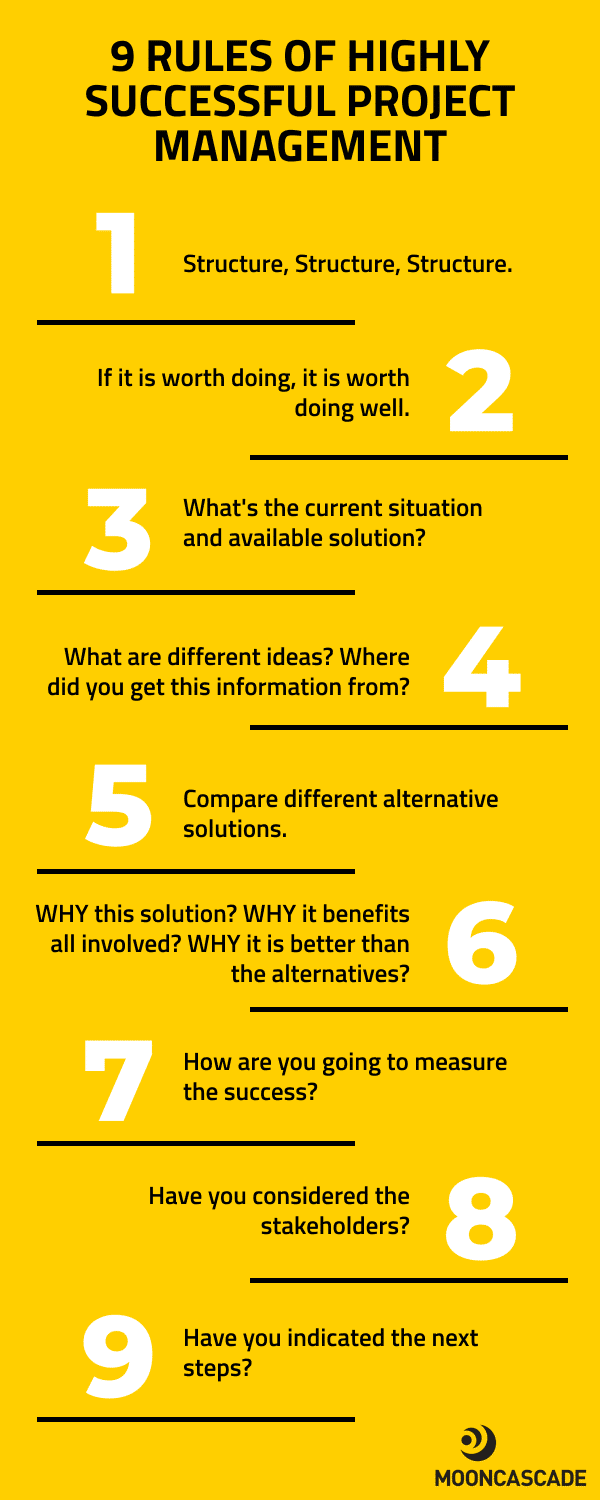9 Rules of Highly Successful Project Management
Just like football coaches study the game, Mooncascade has taken a step back and looked at what are the necessary qualities for a stellar project manager to make projects successful. We’ve then gone ahead and put together this list of 9 project management rules to make your project a success.
Why? Because over the years Mooncascade has noticed similar patterns and mistakes that people make. We’ve seen this on both our own project managers’ side as well as on our clients’ – and believe us – We have made these mistakes as well.
Most likely there has been a situation where you’ve found yourself presenting a kickass idea or product. Now be brutally honest with yourself – has your audiences/reader been sold on it from the very beginning? Or were you in a situation where you needed to defend your “baby” with all that you’ve got?
If the answer is the latter, don’t worry. We’ve got your back, and this list of 9 project management rules will help you crush it every time.

Mooncascade’s Project Management Rules – #1: Structure, structure, structure.
A key to a well-received presentation is structure – and so the first of today’s project management rules deals with establishing that structure. Is it comprehensible? Does it have headings and clear paragraphs? Are the images related to the text or they are randomly placed over the document? The clearer the structure is the better your ideas and key messages will be delivered to your desired audience. Remember the storytelling lessons from high-school: have an introduction, have an outro, and also don’t forget about meaningful content between those two. It is hard to read documents that start talking about the conclusion without even having mentioned what the problem is all about.
Mooncascade’s Project Management Rules – #2: If it is worth doing, it is worth doing well.
“I’ll just jot down something there.”
“I don’t have the software to make a good roadmap.”
These are such terrible excuses. And trust me – everyone will see them. Maybe not everyone will call you out on them, but they most certainly will see them – so the next of today’s project management rules is to simply avoid using them. You might have a brilliant idea worthy of the next top engineer at NASA, but if your proposal is a wall of text sent out as an email body without much effort (but showing clear signs of laziness), then too bad – you are automatically going to lose your audience’s interest. Nobody is interested in a monotone history lecture, we all want something on par with Steve Jobs’ iconic presentations. Do better. Structure and format your documents well. Do your best if you really want to get the job or promote your product idea! Remember – if it is worth doing, it is worth doing well. Otherwise – why bother?!
Mooncascade’s Project Management Rules – #3: Establish the current situation and identify available solutions
It is very common that people often start by addressing the problem. Since people might have grown up with the problem it is human nature to assume that everybody else knows the problem as well. Do your audience a favor – give some background and context – what are we talking about? How many users does it affect? What similar type of questions should you answer for the reader? Even if you are talking about the most well-known bank in the region that everybody should be using, don’t forget that maybe the reader is not from around here at all.
Mooncascade’s Project Management Rules – #4: When identifying alternative solutions, explain your reasoning
The fourth of today’s project management rules deals with information. If you suggest new ideas or solutions then explain why it is a good idea to implement them. What was the concern? Was it just a gut feeling? Is this based on user reviews, customer feedback, competitor analysis, or is it some anomalous workshop result that is causing you to suggest these improvements? Anybody can suggest new ideas, but the reader is also interested in how these ideas surfaced. What is the larger intent behind your ideas and how much actual data and logic lies behind them? Developing based only on gut feeling can be very risky. You won’t always succeed, so increase your chances of success by doing some research beforehand.
Mooncascade’s Project Management Rules – #5: Compare solutions and decide.
If you have several competing ideas then also point out why one solution or idea should be chosen over the other. Again – it might be clear to you as you have done the analysis (maybe in your head) – but it is not clear to the reader. If the pros and cons of the solution and the deciding factors behind the decision to go with ‘solution A’ over ‘alternative B’ are not clearly stated, then your audience might not be convinced that said decision was the correct one. Value-based prioritization might be one of the options that you could consider.
Mooncascade’s Project Management Rules – #6: The 3 most important WHYs.
Describe WHY this solution is good, WHY it benefits all parties involved, and WHY it is better than the current solution or alternatives. This shouldn’t be confused with the previous rule though. Comparing different ideas gives an overview to the reader of why one idea was better than the alternatives. Describing the chosen idea is a more detailed view of it. Who benefits from it? Who has to make contributions? This is where you go all-in with your idea presentation. This is your elevator pitch. Sell your idea to the key stakeholders and explain how this can benefit them. Don’t forget that sometimes you’ll encounter stakeholders who are not using the solution, but are impacted by the outcome or new process itself, having to change something in their day-to-day activities. You can also do some mini design sprints to help to test your product idea.
Mooncascade’s Project Management Rules – #7: Measure performance and success.
Measuring the success (or failure) of a product or feature is a vital part of any product lifecycle – you can’t always rely on your gut feeling. Also relying only on one type of metric might get you on the wrong track, and take away your ability to see beyond it. Don’t rely on customer feedback alone – for example, if you compare the reviews in an app store or user NPS score – you only get the opinion of the user. An average rating of 5.0 means nothing when a product has been downloaded and reviewed by only one customer – so you should also be using additional metrics to measure success. Some examples include – but are not limited to – usage, transaction amount, user retention, new joiners, deposits made. If you can, you should also provide some ballpark figures – what do you expect, what is a good result, what is considered a bad result, etc.
Mooncascade’s Project Management Rules – #8: Consider your stakeholders early on.
People tend to forget stakeholders when presenting ideas. When it comes to product development, developers, QA, designers, and maybe even DevOps are always informed as to the roadmap and plan. BUT, often the most important people are forgotten – what about the customer? Or what about marketing and customer support? Each feature should also have an owner who makes go/no-go decisions. When these stakeholders are forgotten and considered only when it is too late, bad things happen. Don’t let it happen to you. Inform early, and include stakeholders in the original plan. You’ll be glad you did.
Mooncascade’s Project Management Rules – #9: Keep people informed of new developments and future plans.
So you have your plan ready. Everything is clear and ready to go. The future looks bright – but don’t forget about the last of today’s project management rules, which itself deals with mentioning the steps you are planning to take in the future. How might features evolve over time? Are there some other phases coming? What new features could be developed based on your ideas? Keep the reader interested and demonstrate that you can plan a wider roadmap than just delivering for one or two months. It will not only foster the belief that you have things well under control, but it will also enable you to start painting a picture for your audience of what the long term plan looks like.
Overall, good project management just requires a great game plan. We won’t lie to you – you might run into some hiccups, but with these project management rules to guide you, you can overcome any challenge.

